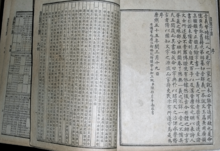Kangxi dictionary
The Kangxi dictionary ( Chinese 康熙字典 , Pinyin Kāngxī Zìdiǎn ) is after the Shuowen Jiezi the second important historical dictionary of the Chinese writing .
scope
The Kangxi dictionary contains 47,000 (mostly hardly used any more) characters.
- structure
- Foreword by Emperor Kangxi : pp. 1–6 ( 御 製 序 )
- Instructions for use: p. 7–12 ( 凡例 )
- Notes on pronunciation: pp. 13–40 ( 等 韻 )
- Table of contents according to radicals : pp. 41–49 ( 總 目 )
- Notes on content: pp. 50–71 ( 检 字 )
- Actual dictionary: pp. 75–1631
- Main text: pp. 75–1538
- Addendum content: pp. 1539–1544 ( 補遺 )
- Addendum Text: pp. 1545-1576
- Appendix Contents: P. 1577–1583 ( 備考 )
- Appendix Text: pp. 1585-1631
- Postscript: pp. 1633–1635 ( 後記 )
- Text research: pp. 1637–1683 ( 考证 )
history
The Kangxi dictionary was created towards the end of the reign of Emperor Kangxi ( 康煕 ) of the Qing Dynasty from 1710 to 1716 under the direction of state officials Zhang Yushu ( 張玉 書 / 张玉 书 ) and Chen Tingjing ( 陳廷敬 / 陈廷敬 ).
The editors reduced the system of 540 radicals of Xǔ Shen to 214 radicals were no longer sorted philosophical considerations but by line count. This system of 214 radicals was first developed for the late Ming period dictionary Zihui ( 字 彙 / 字 汇 ), which was one of the essential sources of the Kangxi dictionary. Under the name "Kangxi radicals", the system is still used in many Chinese character lexicons today.

